Did you know that Thai cuisine is one of the most popular in the world? In a recent international “reader’s pick” poll of delicious foods, numerous Thai dishes are consistently found among the favorites, ranking them among the most popular.
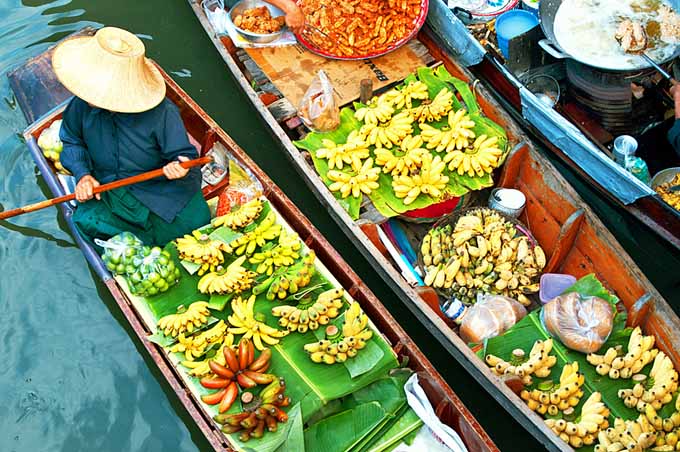
And with the Thai cook’s skillful blending of fresh herbs, spicy sauces, and distinctive flavors, it’s a small wonder that this tantalizing cuisine is a favorite for many.
So let’s check out some of the factors that make the tastes of Thailand so well liked, and then we’ll look at how to create them for ourselves, with a couple of authentic recipes that demonstrate why these dishes are such a hit.
Common Flavors Among Neighbors
Thailand and her close neighbors have influenced one another over the course of many centuries in food, culture, and traditions.
Within the national cuisine called “Thai,” numerous regional variations in dishes and traditions tend to correlate to the proximity of neighboring states.
Not surprisingly, both sides of a given border will often have similar cultural backgrounds and ethnicities, as well as sharing a similar climate and geography.
Neighboring states of Myanmar (formerly Burma), Laos, China, Cambodia, Malaysia, and Vietnam have all had regional influences to some degree, with many popular Thai dishes actually being Chinese in origin.
In the fifteenth and later eighteenth centuries, immigration from China led to strong influences on flavors in the northeast. And, early traders from India and Persia introduced the use of spices, both dried and fresh, that gave rise to Thai adaptations of popular dishes like curry.

Western influence began in the early 1500s with the arrival of the Portuguese, and later included French, Dutch, and English expansionists.
And while Western interests never led to the colonization of Thailand (formerly Siam), it did lead to a common recipe variation that’s become a signature of many beloved Thai dishes – the substitution of coconut milk for cow’s milk.
At first used to create sweets for visiting dignitaries, soon the rich and nutty milk found its way into entree adaptations of Portuguese dishes that are still found on today’s menus.
Perhaps the most significant introduction of an outside flavor was that of chili peppers from the Americas in the sixteenth and seventeenth centuries, arguably one of the most important ingredients in Thai cooking today.
Some of the other important foods introduced at that time include tomatoes, corn, papayas, peas, eggplant, pineapple, pumpkins, cilantro, cashews, and peanuts. All are still very much in use in contemporary dishes today.
Fresh Ingredients
The landscape of Thailand is lush and varied, from fertile river valleys to high mountainous plateaus. And this great diversity is reflected in the broad list of readily available fresh ingredients used in Thai kitchens.
Thai cuisine is internationally known for the use of fresh herbs, spices, and aromatic roots in almost all dishes, and it is composed of four elements: sour, salty, sweet, and spicy.
Some Thai dishs are notorious for their tropical-tinged heat. But the nice thing about cooking Thai: you can balance out dishes that get too spicy with the addition of trademark Thai ingredients, like coconut milk or citrus, without altering their authenticity.
Common flavors include garlic, galangal, coriander or cilantro, lemongrass, shallots, pepper, kaffir lime leaves, shrimp paste, fish sauce, and chilies. Palm sugar is used as a sweetener, while lime and tamarind are common sour flavors.
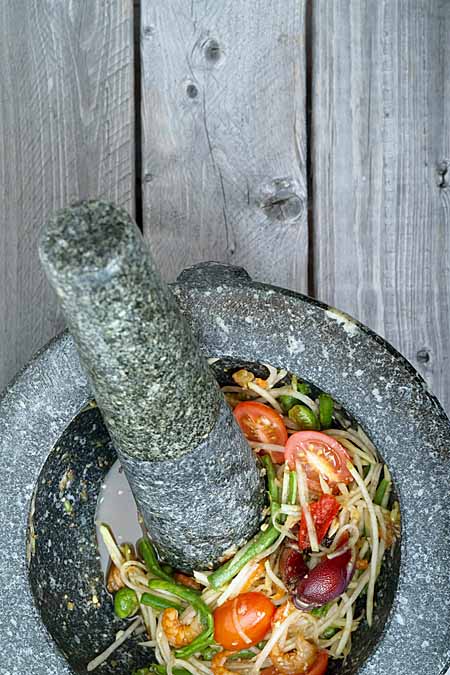
Delicious and flavorful sauces and pastes are also widely used, created by grinding fresh herbs and spices with a mortar and pestle, and then combining these with a fragrant, salty fish sauce – commonly used as a condiment for many dishes.
And shrimp paste is another multi-purpose ingredient that’s often used as a base in both chili and curry pastes, as is soy sauce. Unfortunately, this can be a significant problem for those with shellfish or soy allergies – but not if you are making these dishes at home, which enables you to have full control over the contents.
With its lengthy coastline and the many rivers that empty into the Bight of Bangkok, fish, crustaceans and shellfish of both fresh and salt water varieties are an important part of the cuisine as well.
But, by far, rice is the number one ingredient used in cooking. Rice is actually synonymous with the Thai word for food. There’s also a variety of noodles used in Thai dishes that are typically made from rice, wheat, or mung bean flours. Overall, Thai cooking includes plenty of options for those on a gluten-free diet.
Staples of Thai Cooking
Among some of the staples of Thai cooking you’ll find:
- coconut milk
- fresh turmeric
- curries
- chili peppers
- rice
Commonly used and traditional flavors include herbs and spices such as:
- kaffir lime leaves
- Thai basil
- lemongrass
- coriander or cilantro
- spearmint
- galangal
- ginger
- garlic
- cumin
- cinnamon
- cardamom
- curry powder
- peppercorns
- various additional “special spice blends”
Banana leaves are often used for wrapping and packaging dishes, while the vegetables of choice are eggplant, beans, bamboo shoots, tomatoes, cucumbers, Chinese kale, bok choy, sweet potatoes, squash, and corn. Several types of greens, mushrooms, and flowers are used in this type of cooking as well.
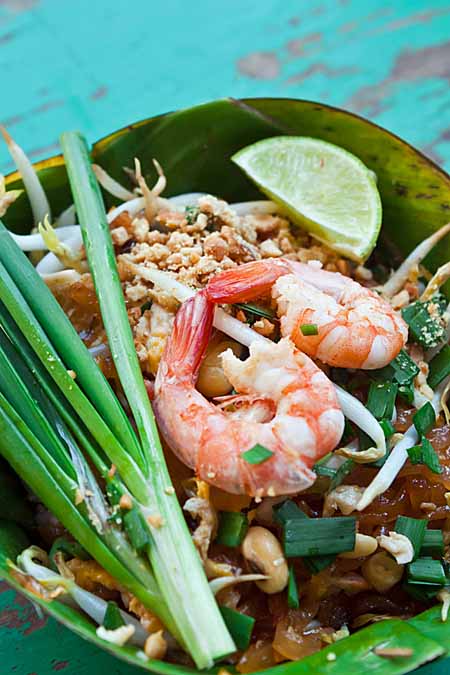
Fruit is served fresh or with a spicy dip, and may include a selection of papaya, mango, lychees, pineapple, pomelo, and rose apples.
And of course, coconuts are important – using every part including the milk, oil, and meat. Most meals are finished with fresh fruit and occasionally a sweet, often prepared with coconut.
Traditions
Some additional culinary traditions that may still be found in Thai households include eating with the right hand, while seated on mats or carpets on the floor.
Western influence gained more ground when kitchen tables and chairs were introduced to the country in the early 1800s, while cutlery, particularly the fork and spoon, first came along in the late 1800s.
A traditional ceramic spoon may be used for soup, while knives are generally not found at the table at all. Sticky rice is also used as an edible utensil, formed into balls and then dipped into a sauce.
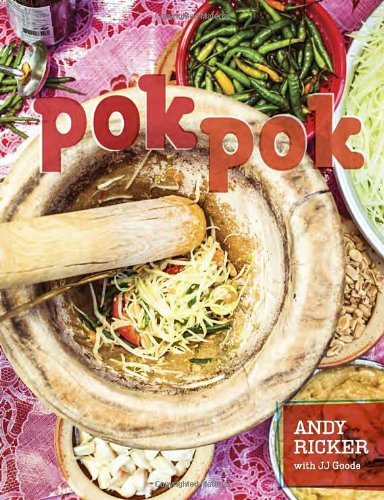
Foodal recommends Andy Ricker’s Pok Pok: Food and Stories from the Streets, Homes, and Roadside Restaurants of Thailand
Historically, most Thai people ate with their hands, as chopsticks were an import from China. In today’s culture, they’re mainly used for Chinese-style noodle soups, often found at Chinese, Japanese, or Korean restaurants.
An everyday Thai meal will normally consist of several items: rice, raw or cooked vegetables with a relish or dip, a broth-like soup, a curry or stew, and a deep-fried or stir-fried dish of meat, seafood, or vegetables.
Sliced cucumbers and plain sticky rice are standard sides dishes used to cool the heat of the spices.
And then there is the custom of “Royal Thai Cuisine.” While the dishes themselves don’t include different ingredients or flavors, there are some nuances in presentation and appearance that set this style apart from everyday fare:
- There are no extremes in the royal versions of dishes, meaning nothing is too spicy hot, and nothing too bland. All ingredients will be in harmonious proportion and balance.
- You won’t find any bones in a royal dish, be it fish, pork, or poultry.
- Fruits and vegetables will have all of the seeds, pits, and peels removed before preparation. And fruits and vegetables may be elaborately carved, for the sake of aesthetics in presentation, and used as decorations.
- Royal dishes are prepared in the most creative ways, beautifully arranged and displayed in colorful porcelain dishes.
Cooking Methods
If you’re looking for a “secret” to successfully create superb Thai dishes, it’s in taking the time to prepare the entire list of ingredients before the actual cooking starts.
This step is particularly significant when you are cooking with a wok – the pace is intense, the heat high, and food is cooked in a short period of time. You don’t want to be dithering about crushing chilies or chopping chives while everything else is cooking on high.
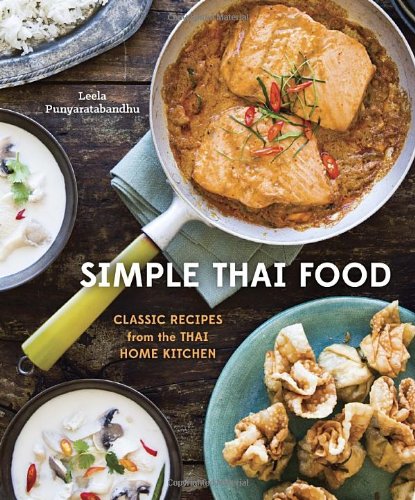
Foodal recommends Simple Thai Food: Classic Recipes from the Thai Home Kitchen by Leela Punyaratabandhu
Thai food is characteristically fresh and crisp, with brightly colored vegetables and seared proteins that retain important nutrients because of the quick and hot cooking style. To stay on top of this fast paced style, the following steps will help:
- Start your preparations with any instructions for making a paste, or grinding spices. You can use a food processor, but a more “hands-on” approach is the traditional Thai method of crushing and grinding with a mortar and pestle for the best possible flavors. If you don’t have one, a spice mill will work as well. Have your spices, pastes, and sauces pre-measured into small ramekins, and lined up in the order required, close to your cooking station.
- The next step is to chop all the veggies into the required shapes and sizes, then stack in cooking order with the spices and pastes, on the counter close to the stove.
- Next, chop up your proteins. Slice and arrange any seafood, poultry, meat, tofu, or meat substitute and stack with your other ingredients. It’s important to prepare fresh meats and veggies separately, and to use separate utensils than you use for preparing cooked items, to avoid cross contamination.
- And finally, have your serving platter clean, warm, and ready to go for serving what you’ve made piping hot from the wok.
In Thailand, chefs commonly use coconut or peanut oils for stir-frying and deep-frying, and for stir-frying, most recipes call for a medium-high to high heat.
The actual cooking methods are really quite simple, and require only a few tools and utensils. The mortar and pestle is a foundational cooking tool, along with a wok (or a deep frying pan if you don’t have one), which is used along with wooden spoons or spatulas for stir frying.
Grills, hot pots, Thai clay pots, steam baskets and rice cookers are other basics, as are bamboo skewers, fruit and vegetable carving sets, and sharp, well-balanced cooks’ knives and cleavers.
Grilling
Thai people do love their fresh seafood and grilled meats, which are usually eaten after dipping into sweet and sour flavored dips.
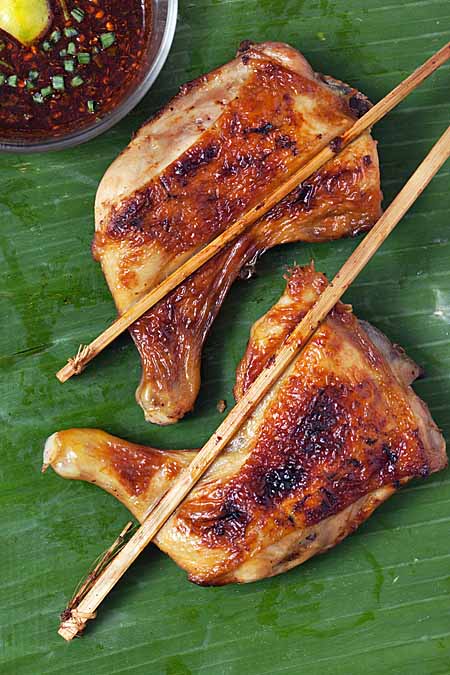
Grilling is done with various heat sources in the form of coals or charcoal, an electric grill, the oven or the stove top, using a heavy griddle pan.
In Thai cooking, meats and other proteins are exposed directly to the heat, or wrapped in leaves or foil, “en papillote” style. Screwpine and banana leaves are commonly used for wrapping, for the lovely fragrances they impart to the cooked food.
Stir Frying
The stir-fry is a method of cooking with direct influence from China, although stir-frying is common all over Thailand. To utilize this quick and no-frills technique, ensure that the wok is hot before adding the oil, then allow it to heat quickly before adding your other ingredients.
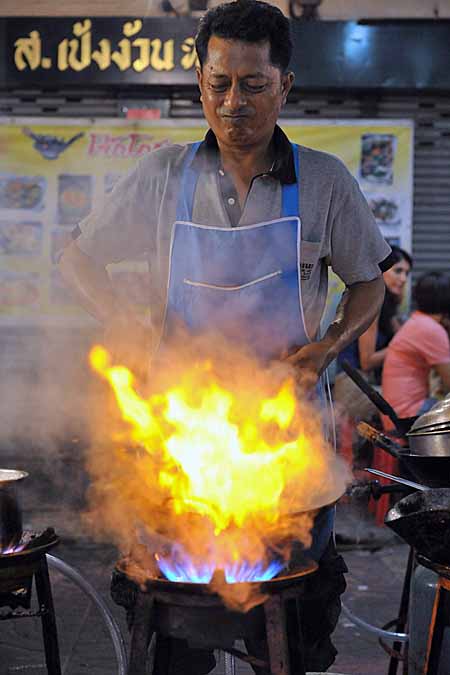
Stir quickly with a spatula to heat through, and as soon as the food is cooked, dish it up and serve hot.
Because the stir-frying process is so quick, have all the ingredients prepped and ready to go before heating the wok, to ensure that some ingredients don’t overcook or burn. Toss ingredients quickly for fast and even cooking.
Try our recipe for Sriracha tofu, green bean, and carrot stir-fry to have fun with this technique!
Stewing and Braising
Stewing helps to retain the full flavors and nutritional goodness of the ingredients, and is superb for tenderizing tougher cuts of meat.
In Thai stews, the ingredients are cut into similar sized pieces and placed into enough liquid to completely immerse them. The pot is covered and placed over low heat for a slow braise.
The juice or broth will sometimes accompany the dish as a side, or it may be either thickened into gravy or reduced to make a pan sauce. The stew is typically served in a ceramic dish.
Steaming
Steaming is another popular method, traditionally using bamboo steamer sets to cook the ingredients over boiling liquid in the wok below.
A nutritious and healthy means of cooking food, for best results use only the freshest ingredients, and cover tightly with a lid to keep the steam in.
Deep Frying
Deep frying is usually done in a wok or a deep pan, and the temperature of the oil is critical to success. Oil that’s not hot enough will result in greasy food, while overheated oil will burn the ingredients.
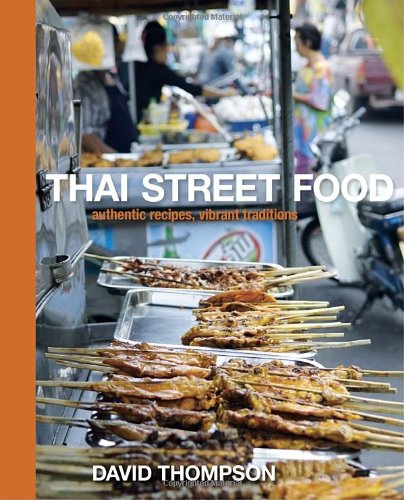
Foodal recommends Dave Thompson’s Thai Street Food
For most Thai dishes, the optimum temperature for deep frying is 350°F. Use a long-handled wire strainer or tongs to remove deep fried foods and drain on a wire rack over absorbent paper, as this will help the food to stay crisp.
Boiling
An important technique in Thai cooking, tasty soups and curries are achieved with well-timed boiling of ingredients.
Salads
While salad preparation isn’t really a technique as such, these dishes are an important part of Thai meals, with their strong tastes and fresh ingredients.
Vegetables and meat are cut into small pieces, combining sourness and saltiness with some spice for heat. Less spicy chili-free dressings are usually available as well, if desired.
A Couple of Easy Thai Recipes For You To Try
That concludes our overview of the sumptuous tastes of Thailand! If you want to explore it a bit further, try out our delicious recipes for authentic Pad Thai or Chicken Satay – if you like Thai food, they’re sure to bring a smile of satisfaction to your face.
Pad Thai with Shrimp
There are many variations of Pad Thai available, so it may be helpful to keep the three primary flavors of salty, sweet, and sour in mind when preparing your version of this popular dish.
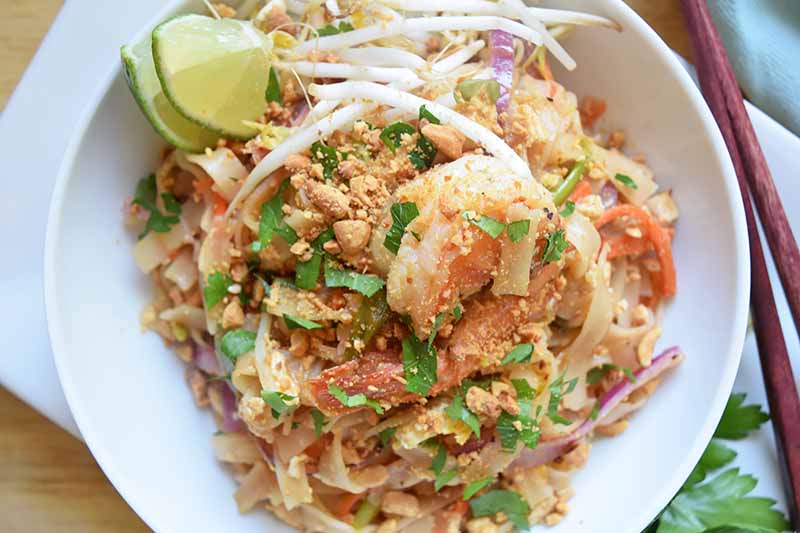
Spicy Peanut Chicken Satay with Cucumber Salad
This delicious chicken satay is marinated, skewered, and then grilled with a spicy peanut sauce – all made from scratch. Easy to make, it’s the perfect one-handed appetizer, ideal for snacking and socializing at the same time… great for summertime backyard parties!
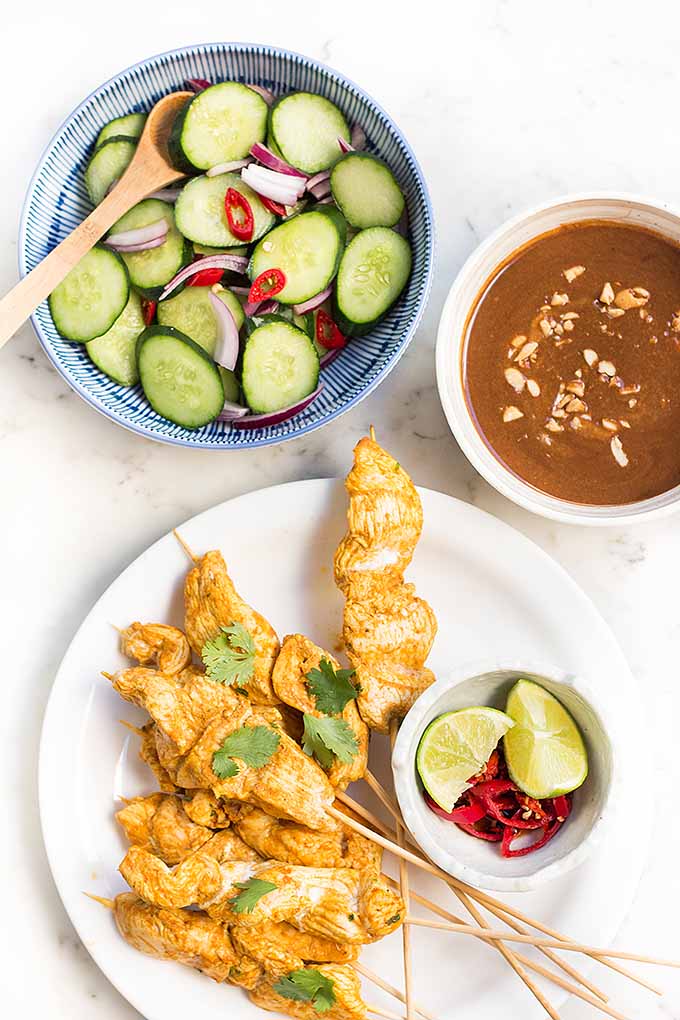
About Lorna Kring
Recently retired as a costume specialist in the TV and film industry, Lorna now enjoys blogging on contemporary lifestyle themes. A bit daft about the garden, she’s particularly obsessed with organic tomatoes and herbs, and delights in breaking bread with family and friends.




Yum, I love Thai food, and there really aren’t that many Thai restaurants near me, so I’ve also become familiar with Vietnamese food, which is more prevalent where I live. I enjoy both, and think your description of how to prepare all of the ingredients in advance, especially ordering them as they will be used, will be particularly helpful as I teach myself to prepare these dishes.
Both cuisines are wonderful, and full of mouth-watering flavors. And you’re right Diane, a little advance preparation will go a long way towards successfully mastering these dishes.
What a rich culinary history Thailand has. I love their food because of all the rich and bold flavors. Unfortunately, there are no restaurants at all in my city and Asian ingredients are also difficult to come by. I’ve recreated some recipes to the best of my ability. They turn out pretty good, but I hope to taste the real deal some day.
Thanks for your comments Nids. It is difficult without any good sources nearby, but adapting recipes to suit can bring about some pretty good results until you can try the real deal.
Many years ago, I went to elementary school with a class mate that was Thai and her parents owned a restaurant near the school. The teachers decided to go visit the restaurant as a field trip and it was the first time many of us experienced eating this style of food including myself.
Sounds like my kind of field trip! Thanks for commenting Jasmine.
I’ve always loved thai food! I’m not the best at making it though, that’s my girlfriend’s speciality! She makes some of the best I’ve ever tasted. I’ll pass these recipes on to her. They look absolutely amazing!
Lucky for you to have someone who specializes in this style of food… Enjoy the recipes!
Count me among the Thai cuisine lovers. The flavors are amazing and the ingredients usually hew pretty closely to my own diet. There’s nothing like a good green papaya salad and Pad Thai, and I’m lucky enough to live fairly close to some lovely restaurants. Not that I visit them often enough!
How fortunate to live close to good Thai restaurants… there’s none close to my home, so it’s my kitchen or a trip into town.
Thai food is amazing so thanks for these recipes – I’ve already decided to try the satay tomorrow night. I’ll definitely be upping the chilli though!
Enjoy the satay missbishi, heat and all!
I’ve also found that Thai food shares many similarities with food of South India. In both curries, there is a prevalent usage of coconut milk and grated coconut, as well as heavy doses of cumin and garlic, and although the taste seems different at first, if you eat enough of both food, you get to notice many similarities in taste . It probably reflects shared culture during the times when a lot of South Indian merchants traveled from India to Thailand, such as around the time of emperor Asoka, or maybe due to similar climates and environments. I haven’t seen any literature confirming this, just my own theory!
Commerce and trade have certainly played a major role in the transfer and development of ideas, and cooking is one area that’s always influenced by these factors… there certainly is a lot of similarities between the two cuisines. Thanks for your comments Raman_U.
Interesting article, I didn’t know Thai cuisine has such a rich history. It’s on my bucket list to visit Thailand one day as I love the food. Unfortunately though, there aren’t any estaurants in my area, so I’ve got to do my best to recreate it at home.
The peanut chicken satay looks incredible. I’m having a dinner party next week and I think my guests would love it. I might have to nix the chilli though, they may not be able to handle the heat!
I hope you and your guests enjoy the satay, maybe just serve some hot sauce or chili relish on the side for those who enjoy the extra inferno effect.
Although I have eaten many of these foods in different forms and varieties I don’t think I have ever had a Thai meal. These recipes and different food combinations are mouth watering. I had no idea they used so many different flavors and varieties in their cooking. It would appear that their diet is a healthy one. I will certainly try these out.
For the most part Thai cuisine is quite light and refreshing oraclemay, hope you enjoy the recipes.
I’m always impressed when I read about Thailand and their cuisine. They have a lot of different flavors which makes their food unique. With that in mind, cooking some of their dishes is pretty hard so you have to have a little bit of knowledge before attempting to cook something with Thai origins.
You’re absolutely right fuzyon, a little knowledge goes a long ways to successful Thai dishes… and a good Asian market helps!
Thank you for all the great information on Thailand’s cuisine. I love asian food in general but Thai food is probably my favorite. I love how the cuisine combines saltiness, sourness, spiciness, and sweetness together into the dishes, all the best flavors in one. It’s so complex and fun to make. I like using new, unique, and hard to come by ingredients in dishes and Thai food definitely has all of those. I will definitely have to check out your cookbook recommendations to learn more.
As you say lebrennan, it’s a rich and wonderful combo of flavors… and a bit of an adventure to make as well, but the results make it all worthwhile!
Reading this post made me crave for Thai food! Perhaps what’s most interesting here is the culture of the people. They live a really simple life but their dishes are just extraordinary. I am also a fan of their creativity in using their local ingredients. Pad Thai is one of my favorite Thai dishes. I like the idea of it being a complete meal. You have your carbs, protein and veggies all in one plate. I will definitely try your recipe! For sure it will be yummy. Thanks!
Both the culture and cuisine are lovely. Hope you enjoy the Pad Thai!
Thank you so much Lorna for rocking once again my kitchen world. Wow you have blown my mind with all this awesome information. You know, I’m a big fan of food and like to eat out a lot, and I’ve always been enamored by these types of dishes, but never thought I could pull them off at home. That is until today. Thank you for taking the time into going into such depth and detail for us, oh and for providing us with a back story. I can’t wait to give these recipes a try!
Happy to rock your kitchen Michelle! At first they do seem a little too exotic for making at home – but really, it’s just a matter of practice. You’ll be enamored with your own dishes in no time. So glad you enjoyed the post!
I’ve tried making Pad Thai, but it just tastes different somehow from the one I had in Thailand. The only difference was that I didn’t own a wok.
The high temperatures definitely make a really huge difference to the outcome of the dish!
Usually my first efforts at trying a new cuisine aren’t quite right either Cheddar – it just takes a bit of patience and experimentation. Thanks for your comments.
I have spent a lot of time in Asia. I’ve traveled to Thailand many times. The food is amazing. Thai restaurants in other countries just don’t do the food justice. Reading this article reminded me of some the outstanding flavors I encountered on my travels. Coconut milk, basil, turmeric, curry….wow!
I’ve only tried to recreate Thai curries at home without much success. I’ve eaten my share of Pad Thai from street vendors, but never considered trying to make it at home. I will give your recipe a try. Thanks.
Their flavors really are outstanding Phoenix, and worth the effort of trying your hand at them in your own kitchen. Hope you enjoy the Pad Thai!
The bit on chili peppers from the Americas is very informative. I’ve always assumed that chili peppers grow abundantly in Thailand. Prior to a vacation in Thailand, I thought I have a taste for Thai food. Haha, boy did I have an awakening when most of the dishes I tried when I was there in 2012 was just too spicy for my liking. So, I figured it must be because they have plentiful supply of peppers that they just have to include peppers in their recipes. I had never thought that it came from an outside influence.
The difference between the real deal and what we find in westernized restaurants is usually jarring saravet… it takes a while for our palates to catch up with what locals can handle.
Isn’t it interesting how the migration of ingredients like chili peppers can influence a region’s cuisine? Glad you enjoyed the post.
Oh, that Bangkok trip was indeed very enlightening! You’re right, it actually took a while before I could adjust. Haha, there was a time that I surrendered and actually went to an American fastfood. I think it was a KFC, and I thought I was safe there. Haha, I ordered what I thought was just ordinary hot and spicy chicken. I was shocked when the meal was bathed with peppers! I eventually had to switch food with a friend. My poor friend had to hastily look for milk to counter the spiciness! Oh, fun memories.
It is indeed very interesting how interaction with neighboring and foreign countries can be a big influence on local cuisines. My country is testament to that – with China being a big influence to our own cooking.
Thai has almost been a favorite in our family. It freshens and beautiful array of flavors is wonderful. However, I have never attempted to make my own Thai dish as I always fear of marring this beautiful cuisine.
Although, I may try this recipe….
The blending of flavors is something wonderful Lupa06, and not so difficult to do at home – I hope you give it a try!
I’m not at all surprised that Thai is the most popular kind of cuisine. I can’t get enough of it myself. Such a wide and exciting range of flavours. Thai curries are to die for and I love what they do with sea food. I think my favourite part is the basil that they use. It’s got to be one of the most prominently used ingredients in Thai cooking. Can’t get enough of it!
I’m totally with you on the basil psanch, it’s hard to think of a food it doesn’t go with! Thanks for your thoughts.
I enjoy a lot of Thai food, but my favourite is a green curry made with chicken or prawns; there’s just something about that combination of flavours that is creamy yet quite refreshing at the same time – utterly delicious. I haven’t had a green curry in a while, but this recipe has got my taste buds tingling for one.
Green curry does have a unique and delicious flavor uk… hope you satisfy those taste buds soon!
No, I didn’t know that this was the most popular cuisine in the world. I’ve learned something today! I would have thought Chinese or Indian cuisines more wide spread and more popular that Thai. However, I’d have voted for Thai because it is so subtle and stunning.
Subtle and stunning sums it up nicely Julie, it’s definitely a taste treat!
Well this might just have to be another one that I just print out and keep around in the kitchen for a little inspiration. I have always loved Thai food but have always been a little intimidated by it when it comes to preparing some myself, but this will certainly help me there. I have to say that seeing the chili pepper influence in the dishes got my mouth watering a bit too, so I have that to look forward to. Thanks for sharing.
A little inspiration can go a long way to satisfying those taste buds rz! Enjoy!